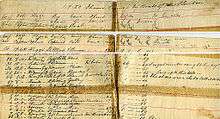Pinnace (ship's boat)

As a ship's boat, the pinnace is a light boat, propelled by oars or sails, carried aboard merchant and war vessels in the Age of Sail to serve as a tender. The pinnace was usually rowed but could be rigged with a sail for use in favorable winds. A pinnace would ferry passengers and mail, communicate between vessels, scout to sound anchorages, convey water and provisions, or carry armed sailors for boarding expeditions.[1] The Spanish favored them as lightweight smuggling vessels while the Dutch used them as raiders. In modern parlance, "pinnace" has come to mean an auxiliary vessel that doesn't fit under the "launch" or "lifeboat" definitions.


Original designs

Identification of some pinnaces in contemporary historical documents is often difficult because there was no standardization of pinnace design, be the type 'small' or 'large'. The term seems to have been applied to variants of what may be called the full-rigged pinnace, rather than the alternative use of the term for a larger vessel's boat. Furthermore, several ship type and rig terms were used in the 17th century, but with very different definitions than applied today. Re-assessment of the design of some 17th-century ships not designated "pinnace" sometimes uncovers the unexpected. For example, in the 17th century, brigantine referred to a two-masted sailing ship that was square-rigged on the foremast, and fore-and-aft rigged on the main mast. The designation 'brig' did not exist until the early 18th century, by which time vessels described as pinnaces had been well known for at least a century and a half.
By the late 17th century, a brigantine in the Royal Navy was a small, square-rigged, two-masted ship, that could be rowed as well as sailed. 'Brig' referred to any ship that was square-rigged on both masts. When 'brig' and 'brigantine' were too widely applied, other possibilities for ship types were obscured.[2] There is also the problem in sorting out what is meant by a 'barque' in the early 17th century. Note that the 'barque' or 'bark' rig as we understand it was not known in the first half of the 17th century, and so exactly what is meant by a 'barque' is not clear. "When Governor Winthrop of the Massachusetts Bay Colony wrote of 'barques', he referred to ships that were both 'small' and 'large' and weighed 12 to 40 tons", thereby suggesting the two types of pinnace and their usual range in tonnage.[3]
Often decked over, the 'small' pinnace was able to support a variety of rigs, each of which conferred maximum utility to specific missions such as fishing, cargo transport and storage, or open ocean voyaging. The mature 'small' pinnace design emerged as versatile with several different options and rigs possible. The expected popularity of the pinnace in the Massachusetts Bay Colony during the first half of the 17th century is documented. By the 1630s, historical records mention many ships trading or fishing with the Massachusetts Bay Colony, some of which were also built in-colony. Above all, the fishing trade had taken hold off the shores of New England, and was immediately successful. The pinnace may have been the preferred, multi-use small ship of the first decades of English settlement in 'Virginia'.[4]
Steam pinnace
With the introduction of steam propulsion came the steam pinnace. Coal burning warships were particularly vulnerable when at anchor, immobile until they could get a head of steam. Steam pinnaces were designed to be small enough to be carried by the capital ships they were allocated to and in addition to other duties were armed to act as picket boats.[5][6]
One example of a ship utilizing many steam pinnace (ship's boats) was HMS London in Zanzibar while suppressing the slave trade in the region:
"Slavery was legal in all Muslim countries, and HM ships could only become involved with slaving when it took place on the high seas. The boats of HMS London were kept at five minutes notice, ready equipped with water, salt pork, biscuits, arms, local currency and a small cask of rum. Manned by eight or nine sailors, with a midshipman or junior lieutenant in command, a boat was often away from the HMS London for two or three weeks, normally anchoring every night, the men off watch sleeping along the thwarts."[7]
References
- ↑ cf Knox, Dudley, ed. (1940). Naval Documents Related to the Wars With Barbary Powers, Naval Operations from 1802 to 1803. II. U.S. Gov't Printing Office. pp. 267; 270. (examples: "[a]t 5 sent our pinnace alongside of a French Man of War (lying at Tunis) with a letter to Consul Eaton. . ."; "[a]t 8 the pinnace returned from the island, she found no bottom within 20 or 30 yards of the shore."; "[a]t 2 lower'd down our pinnace alongside of an American vessel lying in the bay. When the pinnace returned Lieu't Stewart gave us the following interesting news . . .")(extracts from journal of U.S. Frigate Constellation, Captain Alexander Murray, U S Navy, 6 Sept. 1802).
- ↑ "The Sailing Ships of New England, 1607-1907", by John Robinson and George Francis Dow, Marine Research Society, Salem, Massachusetts: 1922, pp.10-11.
- ↑ Some Seventeenth-Century Vessels and the Sparrow Hawk, by William Avery Baker. Pilgrim Society Note, Series One, No.28, 1980. Updated May 18, 2005, retrieved February 2, 2011.
- ↑ "The Sailing Ships of New England, 1607-1907", by John Robinson and George Francis Dow, Marine Research Society, Salem, Massachusetts: 1922, pp.10-11. A house carpenter at the Plymouth Colony in 1624 or 1625 constructed a pinnace from a shallop, an 'extreme make over' that is occasionally noted throughout the 17th century. He sawed a large shallop in half, then lengthened and decked it over to make a pinnace that did "good service for seven years".
- ↑ Steam Pinnace 199
- ↑ Pinnace Gun
- ↑ An illustrated history of the Royal Navy by John Winton, Thunder bay press, 2000
External links
| Wikimedia Commons has media related to Pinnaces. |